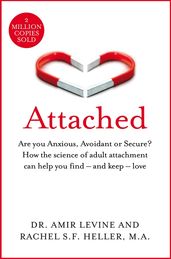Attachment styles 101
What are attachment styles? How many are there and what are the differences? Amir Levine and Rachel Heller, authors of the million-selling Attached, go back to basics.

In their groundbreaking and bestselling self-help book, Attached, psychiatrist and neuroscientist Amir Levine and psychologist Rachel S. F. Heller reveal how an understanding of attachment theory – the most advanced relationship science in existence today – can help us find and sustain love. In this edited extract they explain what we mean by 'attachment styles' and what the three types of attachment style are.
What are attachment styles?
'Attachment styles' categorise the manner in which people perceive and respond to intimacy in romantic relationships. Research findings first made by Cindy Hazan and Phillip Shaver indicate that adults show patterns of attachment to their romantic partners similar to the patterns of attachment of children with their parents. These are classified as either Secure, Anxious or Avoidant. People with each of these attachment styles differ in:
- their view of intimacy and togetherness
- the way they deal with conflict
- their attitude toward sex
- their ability to communicate their wishes and needs
- their expectations from their partner and the relationship
All people in our society, whether they have just started dating someone or have been married for forty years, fall into one of these categories. Adult attachment research has produced hundreds of scientific papers and dozens of books that carefully delineate the way in which adults behave in close romantic ties. These studies have confirmed, many times over, the existence of these attachment styles in adults in a wide range of countries and cultures.
Understanding attachment styles is an easy and reliable way to understand and predict people’s behavior in any romantic situation. In fact, one of the main messages of this theory is that in romantic situations, we are programmed to act in a predetermined manner.
Where do attachment styles come from?
Initially it was assumed that adult attachment styles were primarily a product of your upbringing. Thus, it was hypothesized that your current attachment style is determined by the way in which you were cared for as a baby: if your parents were sensitive, available, and responsive, you should have a secure attachment style; if they were inconsistently responsive, you should develop an anxious attachment style; and if they were distant, rigid, and unresponsive, you should develop an avoidant attachment style. Today, however, we know that attachment styles in adulthood are influenced by a variety of factors, one of which is the way our parents cared for us, but other factors also come into play, including our life experiences.
What are the different attachment styles?
The three different attachment styles are anxious, secure and avoidant.
Anxious
You love to be very close to your romantic partners and have the capacity for great intimacy. You often fear, however, that your partner does not wish to be as close as you would like him/her to be. Relationships tend to consume a large part of your emotional energy. You tend to be very sensitive to small fluctuations in your partner’s moods and actions, and although your senses are often accurate, you take your partner’s behaviors too personally. You experience a lot of negative emotions within the relationship and get easily upset. As a result, you tend to act out and say things you later regret. If the other person provides a lot of security and reassurance, however, you are able to shed much of your preoccupation and feel contented.
Secure
Being warm and loving in a relationship comes naturally to you. You enjoy being intimate without becoming overly worried about your relationships. You take things in stride when it comes to romance and don’t get easily upset over relationship matters. You effectively communicate your needs and feelings to your partner and are strong at reading your partner’s emotional cues and responding to them. You share your successes and problems with your mate, and are able to be there for them in times of need.
Avoidant
It is very important for you to maintain your independence and self-sufficiency and you often prefer autonomy to intimate relationships. Even though you do want to be close to others, you feel uncomfortable with too much closeness and tend to keep your partner at arm’s length. You don’t spend much time worrying about your romantic relationships or about being rejected. You tend not to open up to your partners and they often complain that you are emotionally distant. In relationships, you are often on high alert for any signs of control or impingement on your territory by your partner.
Want to know more?
When people hear about attachment styles, they often have no difficulty recognizing their own style. Some people tell us right away, “I’m anxious,” “I’m definitely avoidant,” or “I think I’m secure.” Others have a harder time figuring it out.
You can find out more about the different styles, identify yours and learn how to sharpen your relationship skills as a result, in Attached.
Attached
by Amir Levine
With fascinating psychological insight, quizzes and case studies, Dr Amir Levine and Rachel Heller help you understand the three attachment styles, identify your own and recognize the styles of others so that you can find compatible partners or improve your existing relationship.
